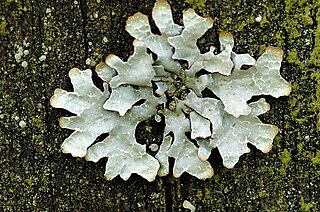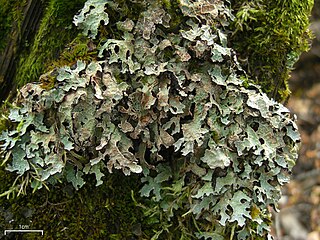
Lobaria is a genus of foliose lichens, formerly classified in the family Lobariaceae, but now placed in the Peltigeraceae. They are commonly known as "lung wort" or "lungmoss" as their physical shape somewhat resembles a lung, and their ecological niche is similar to that of moss.

Parmelia sulcata is a foliose lichen in the family Parmeliaceae. It is very tolerant of pollution and has a cosmopolitan distribution, making it one of the most common lichens. It harbours a unicellular Trebouxia green algal symbiont.

Lobaria pulmonaria is a large epiphytic lichen consisting of an ascomycete fungus and a green algal partner living together in a symbiotic relationship with a cyanobacterium—a symbiosis involving members of three kingdoms of organisms. Commonly known by various names like tree lungwort, lung lichen, lung moss, lungwort lichen, oak lungs or oak lungwort, it is sensitive to air pollution and is also harmed by habitat loss and changes in forestry practices. Its population has declined across Europe and L. pulmonaria is considered endangered in many lowland areas. The species has a history of use in herbal medicines, and recent research has corroborated some medicinal properties of lichen extracts.

Menegazzia terebrata is a species of foliose lichen found scattered across many continents, including North America, South America, Europe, Africa, and Asia.

Esslingeriana is a fungal genus in the family Parmeliaceae. The genus is monotypic, containing the single foliose lichen species Esslingeriana idahoensis, commonly known as the tinted rag lichen. It is found in northwestern North America.

Lobaria scrobiculata, commonly known as the textured lungwort, is a large foliose, epiphytic lichen in the family Peltigeraceae.

Lobaria oregana, also known as lettuce lichen and as Oregon lungwort, is a species of foliose lichen occurring in North American old-growth forests, such as the Hoh Rainforest in Washington state. Taking its common name from its lettuce-like appearance, the lichen grows in the tree canopy but falls to the forest floor, where it is consumed by deer, elk, and other animals. The species was first described by American botanist Edward Tuckerman in 1874 as Sticta oregana, and later (1889) transferred to the genus Lobaria by Swiss lichen specialist Johannes Müller Argoviensis. Via cyanobacteria, it fixes nitrogen from the air, which then enters the local ecosystem when eaten or when absorbed by rootlets which the host trees extend from their own bark into the lichen.

Crustose lichens are lichens that form a crust which strongly adheres to the substrate, making separation from the substrate impossible without destruction. The basic structure of crustose lichens consists of a cortex layer, an algal layer, and a medulla. The upper cortex layer is differentiated and is usually pigmented. The algal layer lies beneath the cortex. The medulla fastens the lichen to the substrate and is made up of fungal hyphae. The surface of crustose lichens is characterized by branching cracks that periodically close in response to climatic variations such as alternate wetting and drying regimes.

Pyxine sorediata, commonly known as mustard lichen, is a widely distributed species of foliose lichen in the family Caliciaceae. It has a subtropical to warm temperate distribution, and grows on bark, rocks, and moss as substrates. Pyxine sorediata has been reported from regions of North America, Europe, Africa, Asia, and Australasia.

Pyxine subcinerea is a species of foliose lichen in the family Caliciaceae. It has a pantropical distribution, and typically grows on bark, but less commonly on rocks. The lichen is characterised by its yellow medulla, soralia on the margins on the lobes that make up the thallus, and the presence of the chemical lichexanthone in the cortex.
Punctelia transtasmanica is a species of foliose lichen in the family Parmeliaceae. It is found in Australasia.
Punctelia involuta is a species of foliose lichen in the family Parmeliaceae. Found in Brazil, it was described as a new species in 2010 by Luciana Canêz and Marcelli Marcelo. It is a member of the Punctelia microsticta species group, a set of related Punctelia lichens with a black lower surface and similar morphology. The type specimen of Punctelia involuta was collected in São Luiz do Paraitinga at the Serra do Mar State Park. In an open forest there it was found growing on mosses at the base of a thin, rotting Myrtaceae trunk; the elevation was 975 m (3,200 ft).

Punctelia reddenda is a widely distributed species of foliose lichen in the family Parmeliaceae. It occurs in Africa, Europe, North America, and South America, where it grows on bark and on rock.
Cetrelia sayanensis is a species of foliose lichen in the family Parmeliaceae. Found in Europe, it was formally described as a new species in 2009 by lichenologists Tatyana Otnyukova, Nikolay Stepanov, and John Alan Elix. The type was collected along the Kulumys ridge on the West Sayan Mountains of southern Siberia. Here it was found growing on the bark of an old stem of Sorbus sibirica, at an altitude of 800 m (2,600 ft). It has also been collected in several neighbouring areas, all at altitudes between 400–930 m (1,310–3,050 ft), with the bark of Abies, Betula, Salix, and Sorbus as the typical substrates. In 2019, the lichen was recorded from Austria, its first reported occurrence in middle Europe.
Pseudoparmelia kalbiana is a species of foliose lichen in the family Parmeliaceae. It is found in South America.
Parmelia mayi is a species of foliose lichen in the family Parmeliaceae. It is found in the northern Appalachian Mountains of eastern North America, where it grows on rocks and on the trunks of paper birch and balsam fir. Parmelia mayi is morphologically indistinguishable from Parmelia saxatilis, but is distinct in its distribution, chemistry, and genetics.

Hypogymnia krogiae, commonly known as the freckled tube lichen, is a species of foliose lichen in the family Parmeliaceae. Found in North America, it was described as a new species in 1973 by Karl Ohlsson. The type specimen was collected near Cheat Bridge, West Virginia by Mason Hale in 1956.

Parmelia barrenoae is a species of foliose lichen in the large family Parmeliaceae. It was formally described as a new species in 2005. Before this, it was lumped together as one of several lichens in the Parmelia sulcata group—a species complex of genetically distinct lookalikes. Parmelia barrenoae is widely distributed, occurring in Europe, western North America, Africa, and Asia.
Psiloparmelia salazinica is a species of foliose lichen in the family Parmeliaceae. It is found in South America.
Remototrachyna sipmaniana is a species of saxicolous (rock-dwelling), foliose lichen in the family Parmeliaceae. It is only known to occur in Bolivia, where it grows on boulders in Yungas mountain cloud forests.












